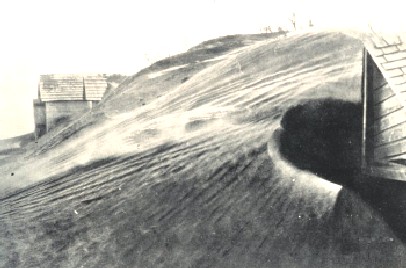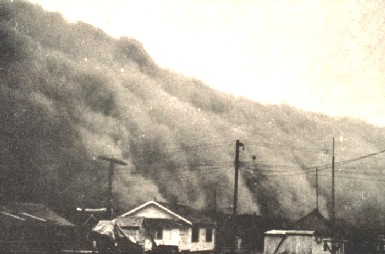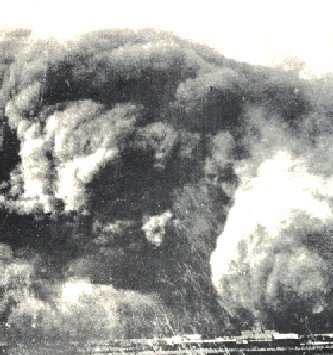|
How Long Will This Drought Go On?
The end of a drought is difficult to predict, because droughts tend to perpetuate themselves. But in time a stronger weather system will break the circuit and good times will return.
So what is a drought?
The first thing to remember about droughts is that they are natural happenings, and an expected part of the climate and weather cycle. The global engine that drives the weather is complex, and minor variations in atmospheric and oceanic circulation can result in significant local changes in temperature and rainfall. If it's abnormally hot and dry, expect a drought. If it's abnormally wet, look for higher ground. Droughts are also widespread and persistent, and at any time somewhere in the USA will be experiencing a drought. The same is usually true for floods. The classic example of this is that during the record Mississippi floods of 1993, parts of the south east were severely affected by drought.
One other feature of droughts is that rain still falls. It's just that there is not enough of it. It's also common, particularly in shorter lived droughts, that some parts of an area may be less affected than others. A couple of local thunder storms can make a big difference if your farm is under their path.
But let's get on with a definition.
As you may expect, because we are dealing with weather and climate, there is no single definition. But drought should be considered as a prolonged lack of expected precipitation.
Hmmmm. To translate a little, expected precipitation is rain or snow that would normally affect an area at a particular time of year - the average or norm. If precipitation has been significantly less than expected for a long period - at least three months - an area is said to be in drought, or drought affected. There are many ways of defining the "significantly less" part. The most common method used in the US is the Palmer Drought Severity Index (PDSI), which compares actual rainfall with the average, with allowance made for temperature.
Types of Drought
There are three generally accepted types of drought, depending on who's talking about them.
The first is the Meteorological Drought - more or less as defined above. In a meteorological drought an area becomes drought affected if precipitation is significantly below average for several months, and the drought is considered to exist until precipitation returns to normal. The key here is the average rainfall - if an area normally gets negligible rain in summer, the absence of rain this summer will not mean the area is in drought.
Hydrological Drought goes a step further. A hydrological drought occurs when an areas water supply is reduced. So an area of low average rainfall where crops are grown using irrigation could be experiencing a hydrological drought if the source of irrigation water dried up, even though local rainfall was normal.
Hydrological drought usually follows the development of a meteorological drought. Normally rain or melted snow will soak into the soil profile, and large volumes of water can be stored there, particularly if the soil is sandy or gravelly. This stored groundwater is what keeps streams flowing after the initial runoff from rain has dried up. It also provides the water used in shallow wells, particularly for irrigation on river flats.
But if there is insufficient rainfall to refill this reserve, its level, identified by saturated soil, slowly drops until it falls below the stream bed. At this time the stream stops flowing, and wells begin to dry. At the same time surface water storage will be drying up, due to both evaporation and usage.
Agricultural Drought reflects the effects of insufficient precipitation on crops and grazing land, and more or less combines the other two definitions. Without adequate water, whether from rainfall or irrigation, crops are put under stress. If the soil around the root zone of grasses, grains and vegetables dries out, they will die. Trees and vines are put under stress and their growth and production is hindered. In grazing areas, the grass dies and stock go begin to starve.
Definitions of agricultural droughts take into account the form of agriculture in an area, and also the stage of growth crops are at when rainfall becomes scarce. Newly planted wheat will be much more severely affected than an established orchard during the early stages of a drought.
Some people identify a fourth form of drought - the Sociological Drought. Because it's not just streams, plants and animals that are affected by drought - it's also the people who own and run the farms, and the communities that service the area.
Prolonged drought can mean no income from the farms, and if the farmer is under financial stress, so are the businesses in the local towns, whose livelihood depends on serving the needs of the rural community.
The effects of drought on communities and people can continue long after the drought has broken - some may never be able to recover. These problems were strongly evident during the Dust Bowl drought of the 1930s, and formed the basis for John Steinbeck's classic novel "The Grapes of Wrath".
Dust Bowl Drought, 1936
The Causes of DroughtMany droughts have no obvious cause. A small change in normal atmospheric circulation may be enough to reduce rainfall for a few months. this can be critical in an area where even normal rainfall is barely adequate for crop growth
Other droughts, particularly those of regional extent, may be related to major short term shifts in atmospheric or oceanic circulation, such as El Nino. Now while El Nino gets blamed for all sorts of things, some of which are due to other causes, its part in the start of some major droughts can be identified.
El Nino is part of a repeated if not regular shift in oceanic currents, tied very closely to variations in air mass position. If, as part of an El Nino event, a warm water mass is replaced by a cooler one, then air over that water body will pick up less water vapour than before.
And if in the normal course events warm moist air formed over that part of the sea is responsible for the rainfall in an adjacent land area, any change to its character will affect the precipitation on land. Less moisture in the air mass may cause seasonal rains to fail, with drought the result.
In either case, local or regional, the affected area is likely to be influenced by an area of high pressure. This usually leads to higher daytime temperatures, less instability in the atmosphere less chance of storm development, and clear skies.
Regardless of the cause, a drought tends to perpetuate itself. Once started, the cycle of clear skies, more hours of sunlight, higher temperatures and higher evaporation tends to sustain itself, and often the situation stays the same until it receives a jolt from a major rain bringing event.
Dust Bowl Drought, 1930s
Agriculturalists now know a lot more about drought management than in the days of the Dust Bowl droughts in the 1930s, and the effects of the shorter droughts can to some extent be countered by a combination of sound land and financial management, always assuming that there are a few good seasons between droughts.
Any area will be drought affected at some time in its history, and that some areas are more drought prone than others.Particularly in the latter areas, selection of crops and stock that are more drought resistant is effective in the long term. Other strategies include using practices which conserve soil moisture, and paying attention to stocking rates to prevent early removal of grass cover.
Hardest of all is to preserve some capital to provide reserve funds for when normal income drops as the drought continues.
So far no proven and reliable methods of rain making have been developed, although cloud seeding trials continue. So for the immediate future we will have to assume that droughts will always be with us, that they will cost us money, and that we should prepare for them as best we can.
Note the size of houses in foreground.
Drought and the Home Weather StationLike Heat Waves, , droughts are not the most exciting of weather events to record on a home weather station.
The typical feature of a drought is more of the same - tomorrow is likely to be the same as today, except maybe hotter. Yet there is always a sense of hope and anticipation.
Although a drought affected area is likely to be situated under a stationary high, air masses and pressure systems are still active elsewhere. Fronts are on the move, but the inertia of the high is usually too great for it to be moved.
Nevertheless, each approaching front, low or convective system may just be the one that brings some local relief, or even acts as the circuit breaker that ends the drought. And the longer the drought goes on, the greater the anxiety level as each potentially relieving system approaches. And unfortunately, the greater the disappointment when there is no significant change. But one day .....
Like To Know More?Firstly, the photos used in this page come from publications from the 1930s, which are included in NOAA's excellent Photo Library .
As usual in matters related to weather, the place to go for resources and further information on drought is the NOAA Drought Page . Related types of hazardous weather are included in the Hot Weather pages.
More information on weather Stations can be found on the Home Weather Stations page, and there is also a page to help you set your weather station up. Back to the Top, or return to the Home page.
You may be interested to know that you can find out more about weather and home weather stations by receiving our newsletter ,"Watching Weather". It's published more or less weekly, and apart from tips on how to use your weather station and understand what it's telling you about the weather around you, it also covers many other weather related topics. If this sounds interesting, just add your name and email address to the form below. When you join, you'll also receive, totally free, a 20 page guide to setting up and trouble shooting problems in home weather stations. And I promise that you won't get spammed, and that your sign up details will remain totally confidential. Sign up now and receive your first issue almost immediately.
Last update 05/24/2011
|







